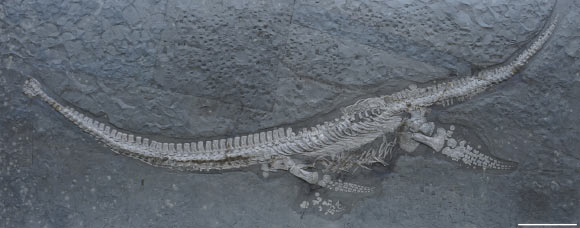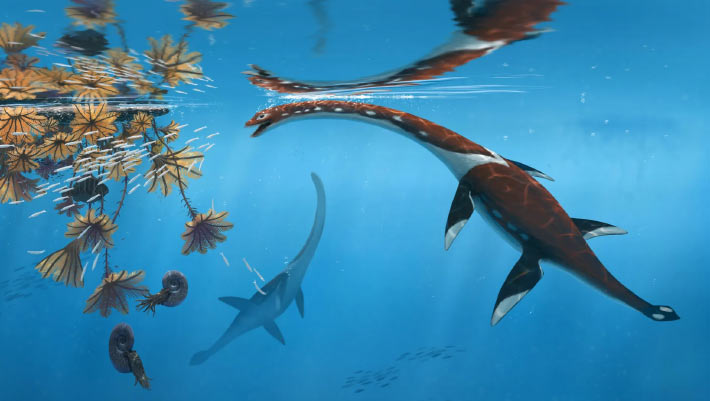Paleontologists have identified an unusual new genus and species of early-diverging plesiosauroid plesiosaur from a nearly complete skeleton found in the Lower Jurassic Posidonia Shale of Holzmaden, Germany.
Life reconstruction of Plesionectes longicollum. Image credit: Peter Nickolaus.
The newly-identified species, Plesionectes longicollum, lived in the Early Jurassic seas around 183 million years ago.
The marine reptile was roughly 3.2 m in length with a 1.25-m long neck and 81-cm long tail.
Its skeleton with remnants of fossilized soft tissue was originally excavated in 1978 from a quarry in the Posidonia Shale, Holzmaden, Germany, but its unique anatomical features have only now been fully recognized through comprehensive scientific analysis.
“This specimen has been in collections for decades, but previous studies never fully explored its distinctive anatomy,” said Dr. Sven Sachs, a paleontologist at the Naturkunde-Museum Bielefeld.
“Our detailed examination revealed an unusual combination of skeletal features that clearly distinguish it from all previously known plesiosaurs.”

Skeleton of Plesionectes longicollum. Scale bar – 30 cm. Image credit: S. Sachs & D. Madzia, doi: 10.7717/peerj.19665.
Plesionectes longicollum is particularly significant as it represents the oldest known plesiosaur from the Holzmaden area.
“This discovery adds another piece to the puzzle of marine ecosystem evolution during a critical time in Earth’s history,” said Dr. Daniel Madzia, a paleontologist at the Polish Academy of Sciences.
“The early Toarcian period when this animal lived was marked by significant environmental changes, including a major oceanic anoxic event that affected marine life worldwide.”
The discovery demonstrates that the Posidonia Shale — already famous for its exceptionally preserved fossils — contained even greater marine reptile diversity than previously recognized.
“The Posidonia Shale at Holzmaden has previously yielded five other plesiosaur species, including representatives from all three major plesiosaur lineages,” the authors said.
“This new addition further cements the formation’s status as one of the world’s most important windows into Jurassic marine life.”
The findings appear online in the journal PeerJ.
_____
S. Sachs & D. Madzia. 2025. An unusual early-diverging plesiosauroid from the Lower Jurassic Posidonia Shale of Holzmaden, Germany. PeerJ 13: e19665; doi: 10.7717/peerj.19665
